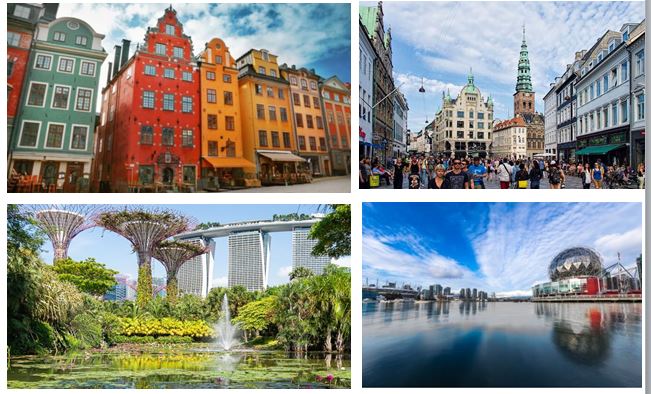Lessons From The Best- Cities Leading With Climate Change Measures
Urbanisation, or the development of more and bigger cities is an inevitable part of the growth cycle around the world today. That makes cities critical players in the climate change fight

Growing population and the threat of global warming on the horizon has seen at least some cities step up to confront their own role in the fight against climate change.
And they do this with the knowledge that they have the power to change the game when it comes to addressing global climate change. As per UN-Habitat, cities account for the production of more than 60 percent of greenhouse gasses and consume about 78 percent of the world’s total energy– even though they cover less than 2% of the total surface of the Earth.
As nations come together with pledges, aiming to keep the planet from warming by more than 2 degrees Celsius by 2050, the efforts of these leading cities bear observation, and adoption where possible, by other cities across the world, especially megapolises in countries like India and China:
Copenhagen Denmark
Copenhagen has come up with a Climate Adaptation Plan that emphasizes a “green and blue” approach. A network of parks, cloudburst boulevards, and retention zones are used to deal with the stormwater at the street level rather than a “grey infrastructural approach” where water is diverted into a city’s existing underground sewage and drainage system.
Copenhagen also aims to become the first carbon-neutral capital city by 2025. The city seems to be well on its way to achieving this aim with its CO2 emissions reduced by 42% since 2005. What is remarkable is that Copenhagen has accomplished all this while still growing in traditional economic terms.
Vancouver Canada
Vancouver, with its location near stunningly beautiful natural forests and habitats, has been leading environmental activism for quite a while. The city has implemented a set of six ‘Big Moves’:
- Negative emissions
- Zero emissions vehicles
- Walkable city
- Active transportation and transit
- Heat pumps
- Embodied carbon
These measures intend to guide the city to take advantage of the key opportunities to reduce warming substantially to 1.5°C and become carbon neutral by 2050.
The city has also approved Climate Emergency Response that supports and advances a range of existing policies including the Renewable City Action Plan, the Greenest City Action Plan, and the Climate Change Adaptation Strategy.
The city’s consistent efforts towards sustainability and clean energy have led to Vancouver having the distinction of the lowest greenhouse gas emissions per person of any major North American city.
Vancouver has also established a stage for businesses, organizations, and citizens to work together, helping it transform into one of the greenest and most climate change resilient cities on Earth.
Stockholm, Sweden
The first European city to be awarded the European Green Capital recognition in 2010, Stockholm aims to be fossil-fuel-free by 2050. The city aims to achieve this goal through various plans one of them being the shift from oil to “district” heating, which means the city and even the country, now utilize centralized sources of heat (e.g. power stations) to effectively heat or cool its buildings.
Another example of how the city engages its citizens is the ‘Stockholm Biochar Project’ which uses waste from parks and gardens to produce biochar and renewable energy. Apart from being a carbon sink, biochar is a fantastic soil conditioner that retains water, air, and nutrients in the soil. And yes, the city is also home for celebrated activist Greta Thunberg,
Singapore
Asia’s most prosperous and dynamic city state has earned the title garden city for itself. Now Singapore aims to be a world leader in green buildings and so far, has been successful.
While most of the city’s buildings have skylights, energy-saving elevators, solar panels, highly efficient air-conditioning units, escalators, and software that monitor the buildings’ level of carbon dioxide emissions; what is unique about the city is that it has numerous vertical gardens as well, which have set a high mark for the rest of the world.
One of the most famous examples of the vertical gardens is the Garden’s Bay, where the trees apart from providing greenery, generate solar power, collect rainwater, and vent air for the nearby conservationists as well.
The above are only a few of the many examples of cities that are successfully combating climate change. These cities have gone from being the cause of climate change to showcasing solutions for combating climate change .
A simple 5-step achievable plan that others can follow is:
- RAISING AWARENESS
While this may be a very common solution it is always the first step towards tackling any problem. Most people, while being aware of the drastically changing climate, do not have any idea as to what the solutions are.
One of the most common misconceptions among citizens is that they expect the government to do something first. But government’s are tied by popular opinion. It is important to communicate the risks from changing climate. Rainwater harvesting, carpooling, saving electricity, planting trees- are some examples of what everyone and anyone can do with government support or otherwise.
Collaboration with other cities, or the ‘sister city’ concept, needs to be enhanced to another level to ensure shared learnings can be transferred faster.
- EMBRACING RENEWABLE ENERGY RESOURCES
One of the most important features of any city is its buildings, and consequently, energy consumption. An abundance of buildings in a relatively compact space means a very high demand for electricity. Today, this energy mostly comes from coal fired electricity. Cities, with the large demand and commercial opportunity they provide, can really give a push to renewable energy, by adopting it more aggressively.
From residents installing their own PV panels, to multi-unit buildings pooling in to buy solar energy by supporting local solar co-operatives, many models have evolved today. Its time for cities to support them.
Another way of embracing renewable resources is by encouraging and implementing rainwater harvesting which will help regenerate groundwater instead of letting rain-water drain into sewage systems.
- IMPROVING PUBLIC TRANSIT
Public transit is one of the top 3 contributors to greenhouse emissions. Cities can substantially cut down on pollution and improve efficiency by investing in electric bus networks, high-speed rails, and modernized subways.
This will also cut down on private cars, ultimately cutting down on road congestion, traffic jams, and noise pollution.
- EXPANDING GREEN SPACES
Amsterdam, Berlin, and Portland.
What is common in these cities? All of them have invested in green spaces. Planting trees and investing in park spaces can solve the problem of what is called the urban heat island effect, filter the pollutants out of the air, and absorb greenhouse gas emissions.
In case of a space crisis, cities can invest in vertical gardens and the best example for this is Singapore. Green spaces improve the quality of lifestyle immensely some other places from where we can draw inspiration are- Latin American countries which have the highest ratio of green space to the population and the city of Vancouver which has mandated that no resident should live more than a five-minute walking distance from a park. It’s an ambition even a mega city like Paris is seeking to replicate, with a 15 minute limit the ambition there.
- TACKLING PLASTIC PROBLEMS AND PURSUING ZERO WASTE
Plastic production clogs landfills and contaminates oceans and waterways, and is also majorly responsible for greenhouse gas emissions. According to a recent study by the Centre of International Environmental Law, plastic production could account for 17% of the global carbon budget by 2050.
A growing trend among in different parts of the world, Zero Waste policies aim to pursue greater recycling and reuse practices with Vancouver, New York and Dubai being world leaders.
Single-use plastic needs to go, before progressively moving on to pursue recycling and reusing methods to cut down on the waste produced. Cities matter because what they do has impact at scale, and due to their role as trend setters. That’s why many experts believe that the battle will be won, or lost, in how our cities adapt.
This article is based on inputs from contributed by Aarushi Mahajan, a Student at Amity International School, Noida.




